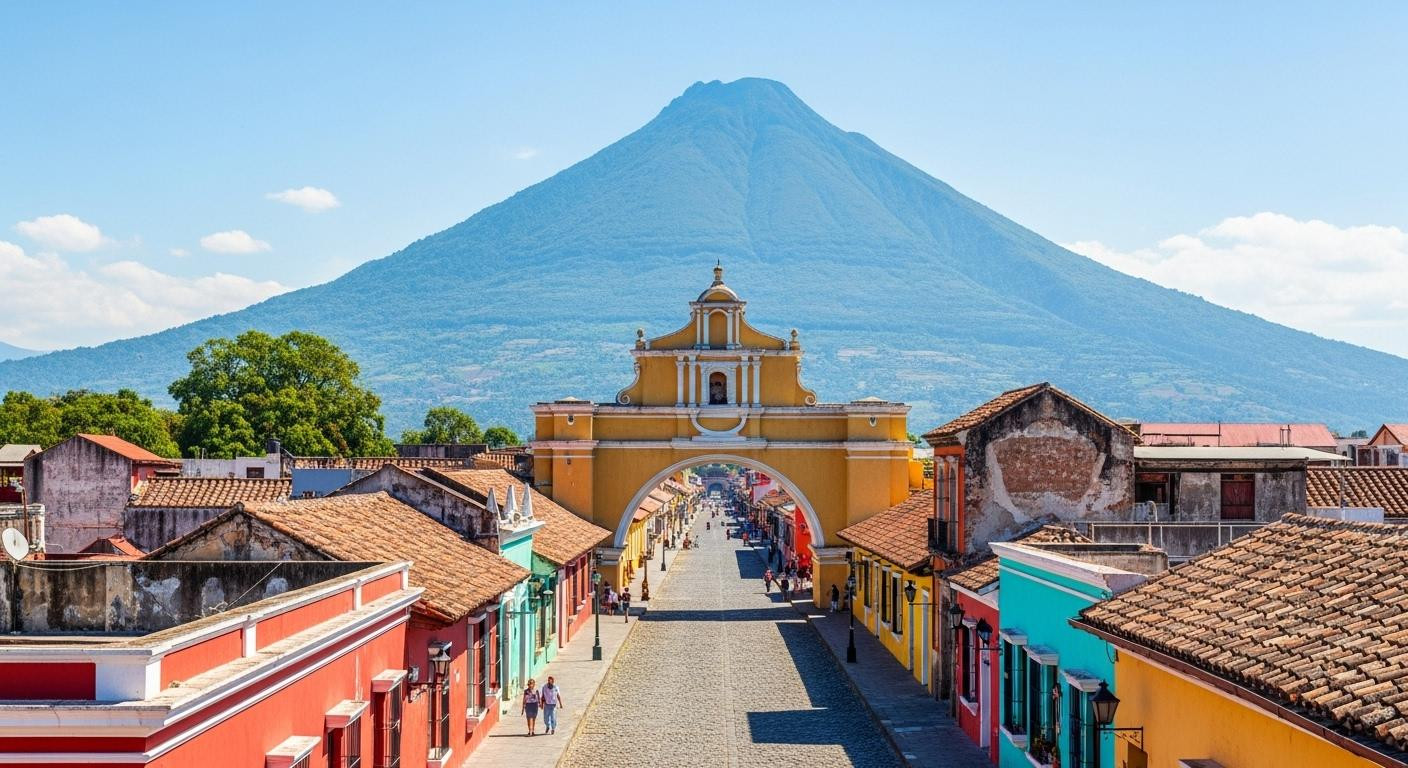Dawn breaks at 6:47 AM on Volcán de Acatenango. Your headlamp beam catches volcanic rock underfoot while Fuego erupts orange across the darkness. Three days ago, you defined adventure as expensive, distant, complicated. Now, standing at 13,045 feet above a UNESCO colonial city where breakfast costs $2.50, something fundamental shifts. Antigua doesn’t just offer volcano hikes and baroque churches. It rewires what you believe transformative travel requires.
The dawn that changes everything
The 4 AM departure from Old Town Outfitters feels surreal in Antigua’s cobblestone streets. By 8 AM, you’re hiking through cloud forest toward Acatenango’s summit. The physical challenge surprises you: 5,269 feet of elevation gain over 8.5 miles.
But returning at sunset transforms everything. You stumble back into streets where vendors prepare tomorrow’s pepián stew and church bells mark evening prayers. The contrast hits differently than Iceland’s $350 volcano tours or Peru’s crowded Inca Trail.
Three volcanoes frame Antigua’s colonial grid: Agua, Acatenango, and active Fuego. You can summit one and stroll 16th-century courtyards within the same day. This intimacy mirrors other overlooked Latin American destinations where scale creates transformation.
What 60,000 residents protect that mass tourism destroys
Antigua’s population density allows something impossible in Cusco or Cartagena: you become part of daily rhythms instead of observing them. Local tourism boards report 650,000 annual visitors compared to Machu Picchu’s 1.5 million crowded into restricted timeframes.
Colonial architecture as living museum
The 1524 Spanish street grid remains intact. Santa Catalina Arch (built 1694) frames Volcán de Agua perfectly. Cathedral of San José’s baroque facade survived the devastating 1773 earthquake that relocated Guatemala’s capital.
Unlike Cartagena’s cruise ship crowds, 95% of Antigua’s UNESCO sites stay accessible on foot. Average walking distance between major landmarks: 0.3 miles. You’re not fighting tour buses for photos.
The rhythm behind the beauty
Church bells from Iglesia de La Merced ring at 7 AM and 7 PM daily. Mercado de Artesanías opens at 8 AM with Mayan textiles priced $15 locally versus $25 for tourists. Family comedores serve traditional chiles rellenos for $4.50.
Semana Santa processions in March create alfombras (colored sawdust carpets) overnight. This cultural continuity provides the same nervous system reset as expensive wellness retreats.
Three days, three transformations
Recent visitor surveys from 2025 show 78% report greater emotional impact from Antigua versus single-focus destinations. The volcano-colonial duality creates what travel research calls “perspective layering.”
Day 1: Physical limits dissolve
Acatenango’s summit success rate reaches 89% during dry season (November-April). Base camp at 12,304 feet offers views of Fuego’s eruptions just 1.5 miles away. Temperatures drop to 15-25°F at night.
The $95 tour package includes transportation, certified guide (1:6 ratio), three meals, and basic shelter. This accessibility transforms how you define adventure compared to Iceland’s $750 overnight volcano experiences.
Day 2: Time moves differently
Post-hike recovery happens at Café Sky’s rooftop (coffee $2.50) with Agua Volcano visible daily. Traditional weaving workshops at Nahualá Textiles cost $25 for two-hour backstrap loom instruction.
Evening strolls through cobblestone streets where families have operated the same shops since 1950. Market vendors recognize you by day three, offering free fruit samples. This personal scale stays impossible in Peru’s tour bus culture.
The contrast that rewires everything
Local historians note how volcanic activity shaped Antigua’s resilient architecture. Lower church walls and reinforced foundations reflect centuries of earthquake adaptation. When you summit Acatenango and see this preserved grid below, geology and human survival interconnect.
Cost comparisons prove transformation doesn’t require expense: three-day Antigua volcano plus colonial experience totals $220-300. Reykjavik equivalent: $750-1,200. Machu Picchu plus Cusco: $450-650. Budget-conscious travelers discover authentic transformation without premium pricing.
Your questions about Antigua, Guatemala: Volcanic hikes and colonial heritage answered
When do volcano hikes offer the clearest views?
November-April dry season provides 80% clear summit probability. December-February delivers coldest nights (ideal for witnessing Fuego’s lava flows). Book 2-3 days advance for weekend departures. October 2025 weather data shows 82% visibility and optimal 5:30 AM-9:00 AM hiking windows.
What makes Antigua’s colonial heritage accessible versus other UNESCO sites?
Antigua’s 5,000-foot elevation requires minimal altitude adjustment compared to Cusco’s 11,150 feet. The 60,000 population maintains livability without overtourism. Free walking access to most ruins and churches versus ticketed entry systems elsewhere. Average tourist density: 8.2 people per square meter versus Cartagena’s 10.3.
How does Antigua compare cost-wise to other volcanic destinations?
Two-day Acatenango trek costs $95 all-inclusive. Ecuador’s Cotopaxi equivalent: $220. Iceland volcano tours: $150-400. Accommodation ranges $50-150 nightly versus $220-350 in Reykjavik. Daily authentic meals: $12-15 versus Iceland’s $65-85.
Steam rises from morning coffee on Café Sky’s rooftop. Volcán de Agua glows pink in sunrise while cobblestones below echo with market preparations. Three days transformed what you believed about adventure’s price, distance, and accessibility. Antigua didn’t just show you volcanoes and history. It showed you a different way to travel entirely.
